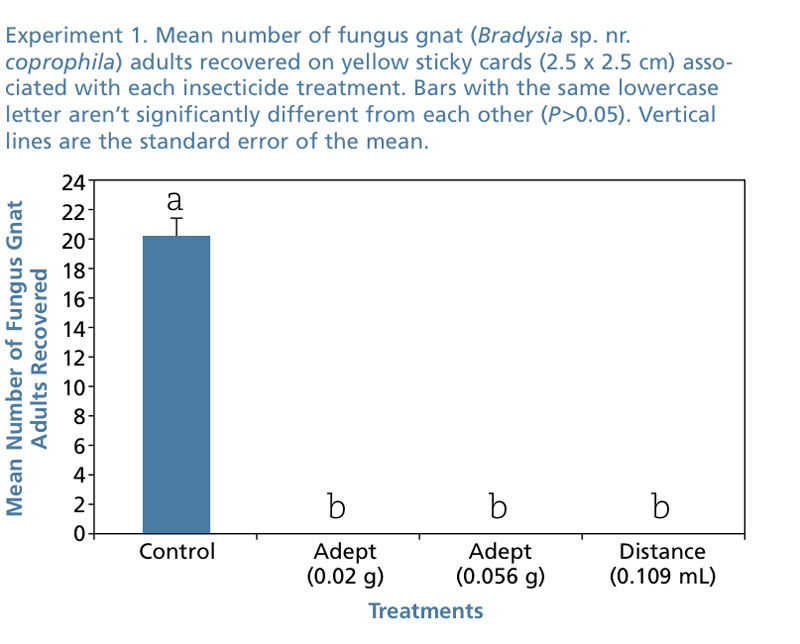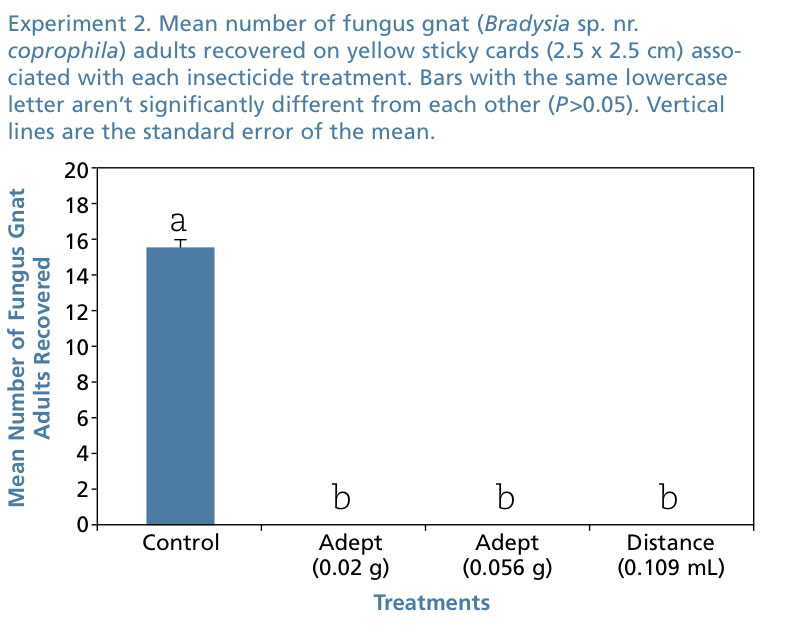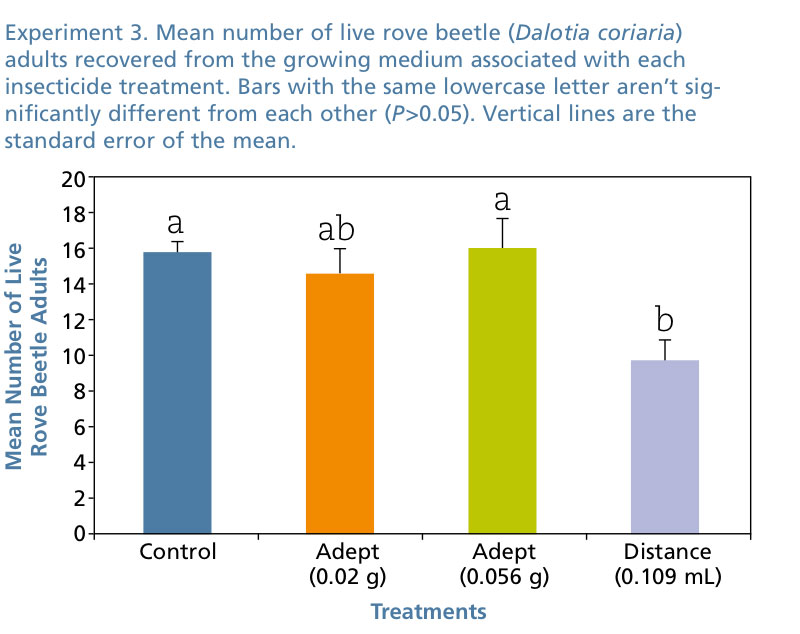9/1/2019
Insect Growth Regulators on Fungus Gnat Larvae & Rove Beetle Adults
Dr. Raymond A. Cloyd
Fungus gnats (Bradysia spp.) are major insect pests in the early stages of crop production—especially during propagation—because the larvae, which reside in the growing medium, feed directly on roots or tunnel into cuttings. However, there are a number of plant protection options available to manage fungus gnat larval populations, such as the use of insect growth regulators or biological control agents.
The insect growth regulators available for use against fungus gnat larvae include cyromazine (Citation), diflubenzuron (Adept) and pyriproxyfen (Distance/Fulcrum). Cyromazine and diflubenzuron are both chitin synthesis inhibitors, whereas pyriproxyfen is a juvenile hormone mimic. The biological control agents that can be released/applied to regulate fungus gnat larval populations include Stratiolaelaps scimitus (predatory mite), Steinernema feltiae (beneficial nematode) and Dalotia coriaria (predatory rove beetle).
However, there may be issues associated with simultaneously using insect growth regulators along with biological control agents. Consequently, the following study was conducted to determine the effect of diflubenzuron (Adept) and pyriproxyfen (Distance) on fungus gnat (Bradysia sp. nr. coprophila) larvae, as well as on rove beetle (Dalotia coriaria) adults in the growing medium.
Materials and methods
A series of experiments were conducted to assess the effects of two commercially available insecticides (insect growth regulators) when applied at the recommended label rate(s) to the growing medium on fungus gnat larvae and rove beetle adults.
 Experiment 1:
Experiment 1:
The effects of two insecticides, diflubenzuron (Adept) at a low (0.026/700 mL water) and high (0.056/700 mL water) rate, and pyriproxyfen (Distance) at a rate of 0.109 mL/700 mL water on fungus gnat larvae was evaluated. Effects were determined after 20 fungus gnat larvae were applied to the growing medium 24 hours before applying the insecticides in 473 mL deli containers. There were 10 replications per treatment.
Three-hundred milliliters of the growing medium, Sunshine LC1 Professional Growing Mix (Sun Gro Horticulture) consisting of Canadian sphagnum peat moss, coarse perlite, starter nutrient charge (with gypsum) and dolomitic limestone was measured using a 600 mL glass beaker and placed into a 473 mL deli container. Modified lids with insect screening were used to allow for ventilation.
Individual insecticides were measured using a 1 mL sterile syringe for pyriproxyfen (liquid) and a balance scale for diflubenzuron (solid formulation). The insecticides were mixed with water separately using a glass beaker in order to obtain the adequate concentration for each insecticide treatment. Subsequently, 70 mL of each insecticide was applied uniformly as a drench to the growing medium in each 473 mL deli
container.
A water control was included in all experiments. Water was poured into a plate placed at the base of the containers and the growing medium was moistened by capillary action. A 2.5 x 2.5-cm yellow sticky card was affixed to the underside of the lid of the containers to capture fungus gnat adults after emergence (approximately 28 days).
 Experiment 2:
Experiment 2:
The residual effect of the insecticides was determined approximately 60 days after application. Fungus gnat males and females were collected from a laboratory colony (Department of Entomology, Kansas State University) to form mated pairs. The mated pairs were maintained separately for 24 hours in a plastic vial before being released into the deli containers, 22 days after applying the designated insecticides. Water was poured into a plate placed at the base of the containers and the growing medium was moistened by capillary action.
A 2.5 x 2.5-cm yellow sticky card was affixed to the underside of the lid of the containers to capture fungus gnat adults after emergence. Adults were counted after 50 days from the initial application of the insecticide treatments. There were five replications per treatment.
Experiment 3:
In order to assess the effect of the two insecticides on rove beetle adults, 20 rove beetle adults (males and females of various ages) were randomly collected from a laboratory colony (Kansas State) by sieving the growing medium using #5 and #10 mesh size sieves. Adults were aspirated into a 9 dram (32 mL) plastic vial and then placed into a deli container.
Initially, the containers were warmed by heat lamps situated about 90 cm above the containers for 24 hours, thus allowing the growing medium to dry, which facilitated the sieving procedure. Ten days after applying the insecticide treatments (as described above), adults were collected by sieving and the number of live rove beetle adults was recorded. There were five replications per treatment.
Statistical analysis
Data from the three experiments were analyzed using a statistical analysis software program (SAS Systems for Windows, version 9.2). Data associated with the effects of the insecticides on fungus gnat larvae and rove beetle adults were subject to an analysis of variance (ANOVA) using the PROC ANOVA procedure with the number of fungus gnat adults captured on the yellow sticky cards and the number of live adult rove beetle adults recovered as the response variables (main effects). Any significant differences among the treatments were determined using a Tukey’s least significant means test at a significance level of α=0.05.

Results/discussion
Results from the study are presented in Figures 1 through 3. For experiments 1 and 2, there was a significant difference (P≤0.05) among the insecticide treatments in regards to the mean number of fungus gnat adults captured on the yellow sticky cards. In fact, there were no fungus gnat adults captured on any of the yellow sticky cards (Figures 1 and 2) associated with the insecticide treatments indicating that both insect growth regulators provided nearly 100% mortality (natural mortality could also have been involved).
In experiment 3, there was a significant difference (P≤0.05) among the insecticide treatments. The diflubenzuron (Adept) treatments (n=2) weren’t significantly different from the water control, whereas the pyriproxyfen (Distance) treatment was significantly different from the water control (Figure 3).
The diflubenzuron (Adept) treatments didn’t negatively affect survival of adult rove beetles, whereas the pyriproxyfen (Distance) treatment had the lowest adult survival (Figure 3) indicating that this insect growth regulator may have negatively impacted rove beetle adult survival.
The information associated with this study is important to greenhouse producers that want to integrate insect growth regulators with biological control agents without compromising the effectiveness of their biological control program in propagation. GT
Dr. Raymond A. Cloyd is Professor and Extension Specialist in Horticultural Entomology/Plant Protection for Kansas State University in Manhattan, Kansas. He can be reached at (785) 532-4750 or rcloyd@ksu.edu.